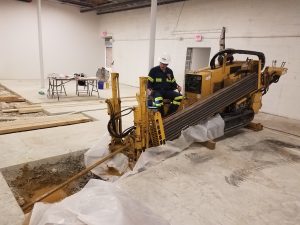Vapor Intrusion Mitigation Using HDD
DTD crews recently completed the installation of a horizontal SVE in Northern CA. The well is part remediation well and part active vapor intrusion mitigation system. Not only will the well remove chlorinated solvent impacted vapors from below the former dry cleaner, but it will also serve the crucial role of sub-slab depressurization.
Vapor intrusion mitigation is currently a hot topic in the environmental industry. Our understanding of how vapor phase concentrations of contaminants below a building affect indoor air quality continues to evolve. As a result of recent EPA assessments, many agencies have tightened regulations in this area, particularly at sites impacted by chlorinated solvents. Combined with relatively strong commercial real estate markets around the US, environmental consultants have found themselves designing lots of vapor intrusion mitigation systems lately.

Limited Access HDD Rig Installing SVE Wells Underneath a Building Slab
Does HDD Make Sense for Vapor Intrusion Mitigation?
Of course for new construction, there are many engineering controls that can be incorporated into the building design as preventative measures. However, existing buildings require modifications, and when the building in question is occupied, it can be quite the logistics puzzle. The landlord doesn’t want to kick out their tenants, even temporarily, for system construction. However, many system designs involve extensive concrete cutting and trenching. Using Horizontal Directional Drilling (HDD) to install soil vapor extraction wells is a non-intrusive method to achieve many vapor intrusion mitigation system goals. There are some limitations, though, and it’s important for practioners to understand the applicability of horizontal wells for their project.
Is Remediation Also an Objective?
For horizontal wells to pay off, it is important to identify the ultimate goal of the project. Horizontal wells add significant value if project objectives include addressing the source of the vapor phase contamination (i.e. remediation). If remediation is not an objective, there are simpler and more economical ways to install a “sub slab depressurization” (SSD) system than drilling wells with HDD.
The goal of an SSD is to create a negative pressure barrier beneath the slab of the building. This barrier interrupts intrusion of soil vapors into the building’s air space. A small sump tapped into the gravel base below the slab will usually suffice to create a negative pressure barrier. A low CFM fan vented to the building roof provides just enough air flow from the sump.
This type of system does interrupt the intrusion of impacted vapors from the subsurface. But it doesn’t address the source of the problem. The vapors are still impacted with volatile contaminants. So, a low flow SSD might only meet minimal indoor air regulations. This minimal compliance could permit the continued occupation of the building, but the site is unlikely to get closure. The burden of the contaminated subsurface will continue to weigh on the responsible party until they address the source of the impacted vapors (the plume).
Horizontal Wells Can Serve Multiple Roles
Horizontal SVE wells have a proven track record for rapid remediation of impacted soil vapors at contaminated sites. Long screen lengths maximize the contact between well screen and the impacted formation. This accelerates mass removal compared to vertical wells. A horizontal well creates an oblong, elliptical zone of vacuum influence centered around the screen interval. This influence extends both horizontally and vertically from the well screen. If the well is positioned correctly, this zone of influence can intersect the gravel base beneath the slab. This allows the well to provide the negative pressure barrier of an SSD while also driving remediation through mass removal.
If you’re concerned with both remediation and vapor intrusion mitigation as concurrent objectives, horizontal SVE wells installed using HDD are an excellent solution. If you have a project that might be a good fit for directionally drilled horizontal wells, please contact us so we can discuss it further with you.
Tags: chlorinated solvents, directional drilling, horizontal SVE, indoor air, remediation, soil vapor extraction, sub slab, vapor intrusion, VI Mitigation